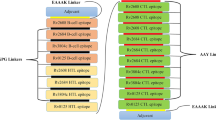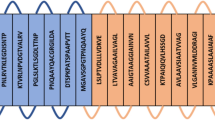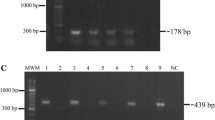Abstract
Purpose
This study was aimed at characterising Mycobacterium tuberculosis (Mtb) H37Rv Rv0292 protein peptides. As this protein forms a structural part of the cell wall and Mtb type VII secretion system, it is believed that Rv0292 has important functions regarding the disease’s pathogenesis and could represent a good candidate when designing a synthetic anti-tuberculosis vaccine.
Methods
Receptor-ligand binding assays were used for identifying peptides from the Rv0292 protein sequence having high specific binding activity (HABP) to infection target cells; some HABPs were able to inhibit Mtb H37Rv entry to such cell lines in in vitro assays. Fluorescent microsphere internalisation assays were carried out for corroborating such peptides’ role in mycobacterial entry. The protein’s predicted alfa helical structure was confirmed by circular dichroism of the peptides forming its sequence.
Results
It was found that peptide 31050 (101 LTLIARYLDRYGIRADTIRI 120) had high binding capacity for the cell lines used here and inhibited mycobacterial entry to such cell lines; it was also found that this peptide was not recognised by sera from individuals who had been in contact with the mycobacteria.
Conclusions
The aforementioned characteristics led to suggesting that peptide 31050 sequence plays an important role in Mtb H37Rv Rv0292 protein interaction with infection target cells and could be considered a candidate when designing a synthetic anti-tuberculosis vaccine.





Similar content being viewed by others

References
Abebe F, Bjune G (2009) The protective role of antibody responses during Mycobacterium tuberculosis infection. Clin Exp Immunol 157(2):235–243
Abu-Raddad LJ, Sabatelli L, Achterberg JT, Sugimoto JD, Longini IM Jr, Dye C, Halloran ME (2009) Epidemiological benefits of more-effective tuberculosis vaccines, drugs, and diagnostics. Proc Natl Acad Sci USA 106(33):13980–13985
Berthet FX, Rasmussen PB, Rosenkrands I, Andersen P, Gicquel B (1998) A Mycobacterium tuberculosis operon encoding ESAT-6 and a novel low-molecular-mass culture filtrate protein (CFP-10). Microbiology 144(Pt 11):3195–3203
Bitter W, Houben EN, Bottai D, Brodin P, Brown EJ, Cox JS, Derbyshire K, Fortune SM, Gao LY, Liu J, van GeyPittius NC, Pym AS, Rubin EJ, Sherman DR, Cole ST, Brosch R (2009) Systematic genetic nomenclature for type VII secretion systems. PLoS Pathogens 5(10):e1000507
Caceres SM, Ocampo M, Arevalo-Pinzon G, Jimenez RA, Patarroyo ME, Patarroyo MA (2011) The Mycobacterium tuberculosis membrane protein Rv0180c: evaluation of peptide sequences implicated in mycobacterial invasion of two human cell lines. Peptides 32(1):1–10
Carabali-Isajar ML, Ocampo M, Rodriguez DC, Vanegas M, Curtidor H, Patarroyo MA, Patarroyo ME (2018) Towards designing a synthetic antituberculosis vaccine: the Rv3587c peptide inhibits mycobacterial entry to host cells. Bioorg Med Chem 26(9):2401–2409
de Souza GA, Leversen NA, Malen H, Wiker HG (2011) Bacterial proteins with cleaved or uncleaved signal peptides of the general secretory pathway. J Proteomics 75(2):502–510
Diaz DP, Ocampo M, Varela Y, Curtidor H, Patarroyo MA, Patarroyo ME (2017) Identifying and characterising PPE7 (Rv0354c) high activity binding peptides and their role in inhibiting cell invasion. Mol Cell Biochem 430(1–2):149–160
El-Shazly S, Ahmad S, Mustafa AS, Al-Attiyah R, Krajci D (2007) Internalization by HeLa cells of latex beads coated with mammalian cell entry (Mce) proteins encoded by the mce3 operon of Mycobacterium tuberculosis. J Med Microbiol 56(Pt 9):1145–1151
Griffin JE, Gawronski JD, Dejesus MA, Ioerger TR, Akerley BJ, Sassetti CM (2011) High-resolution phenotypic profiling defines genes essential for mycobacterial growth and cholesterol catabolism. PLoS Pathogens 7(9):e1002251
Houben EN, Korotkov KV, Bitter W (2014) Take five-type VII secretion systems of mycobacteria. Biochim Biophys Acta 1843(8):1707–1716
Houghten RA (1985) General method for the rapid solid-phase synthesis of large numbers of peptides: specificity of antigen–antibody interaction at the level of individual amino acids. Proc Natl Acad Sci USA 82(15):5131–5135
Jacobs AJ, Mongkolsapaya J, Screaton GR, McShane H, Wilkinson RJ (2016) Antibodies and tuberculosis. Tuberculosis 101:102–113
Kaufmann SH, Weiner J, von Reyn CF (2017) Novel approaches to tuberculosis vaccine development. Int J Infect Dis 56:263–267
Maciag A, Dainese E, Rodriguez GM, Milano A, Provvedi R, Pasca MR, Smith I, Palu G, Riccardi G, Manganelli R (2007) Global analysis of the Mycobacterium tuberculosis Zur (FurB) regulon. J Bacteriol 189(3):730–740
Malen H, Pathak S, Softeland T, de Souza GA, Wiker HG (2010) Definition of novel cell envelope associated proteins in Triton X-114 extracts of Mycobacterium tuberculosis H37Rv. BMC microbiology 10:132
Ocampo M, Aristizabal-Ramirez D, Rodriguez DM, Munoz M, Curtidor H, Vanegas M, Patarroyo MA, Patarroyo ME (2012) The role of Mycobacterium tuberculosis Rv3166c protein-derived high-activity binding peptides in inhibiting invasion of human cell lines. Protein Eng Des Sel 25(5):235–242
Ocampo M, Curtidor H, Vanegas M, Patarroyo MA, Patarroyo ME (2014a) Specific interaction between Mycobacterium tuberculosis lipoprotein-derived peptides and target cells inhibits mycobacterial entry in vitro. Chem Biol Drug Des 84(6):626–641
Ocampo M, Patarroyo MA, Vanegas M, Alba MP, Patarroyo ME (2014b) Functional, biochemical and 3D studies of Mycobacterium tuberculosis protein peptides for an effective anti-tuberculosis vaccine. Crit Rev Microbiol 40(2):117–145
Patarroyo ME, Bermudez A, Patarroyo MA (2011) Structural and immunological principles leading to chemically synthesized, multiantigenic, multistage, minimal subunit-based vaccine development. Chem Rev 111(5):3459–3507
Patarroyo ME, Bermudez A, Moreno-Vranich A (2012) Towards the development of a fully protective Plasmodium falciparum antimalarial vaccine. Expert Rev Vaccines 11(9):1057–1070
Provencher SW, Glockner J (1981) Estimation of globular protein secondary structure from circular dichroism. Biochemistry 20(1):33–37
Rodriguez GM, Voskuil MI, Gold B, Schoolnik GK, Smith I (2002) ideR, an essential gene in Mycobacterium tuberculosis: role of IdeR in iron-dependent gene expression, iron metabolism, and oxidative stress response. Infect Immun 70(7):3371–3381
Rodriguez DC, Ocampo M, Reyes C, Arevalo-Pinzon G, Munoz M, Patarroyo MA, Patarroyo ME (2016) Cell-peptide specific interaction can inhibit Mycobacterium tuberculosis H37Rv infection. J Cell Biochem 117(4):946–958
Sanchez-Barinas CD, Ocampo M, Vanegas M, Castaneda-Ramirez JJ, Patarroyo MA, Patarroyo ME (2018) Mycobacterium tuberculosis H37Rv LpqG protein peptides can inhibit mycobacterial entry through specific interactions. Molecules 23(3):526
Sassetti CM, Boyd DH, Rubin EJ (2003) Genes required for mycobacterial growth defined by high density mutagenesis. Mol Microbiol 48(1):77–84
Sreerama N, Woody RW (2000) Estimation of protein secondary structure from circular dichroism spectra: comparison of CONTIN, SELCON, and CDSSTR methods with an expanded reference set. Anal Biochem 287(2):252–260
Stanley SA, Raghavan S, Hwang WW, Cox JS (2003) Acute infection and macrophage subversion by Mycobacterium tuberculosis require a specialized secretion system. Proc Natl Acad Sci USA 100(22):13001–13006
Tellier R, Li Y, Cowling BJ, Tang JW (2019) Recognition of aerosol transmission of infectious agents: a commentary. BMC Infect Dis 19(1):101
Van GeyPittius NC, Gamieldien J, Hide W, Brown GD, Siezen RJ, Beyers AD (2001) The ESAT-6 gene cluster of Mycobacterium tuberculosis and other high G + C gram-positive bacteria. Genome Biol 2(10):RESEARCH0044
van Pinxteren LA, Ravn P, Agger EM, Pollock J, Andersen P (2000) Diagnosis of tuberculosis based on the two specific antigens ESAT-6 and CFP10. Clin Diagn Lab Immunol 7(2):155–160
Vera-Bravo R, Torres E, Valbuena JJ, Ocampo M, Rodriguez LE, Puentes A, Garcia JE, Curtidor H, Cortes J, Vanegas M, Rivera ZJ, Diaz A, Calderon MN, Patarroyo MA, Patarroyo ME (2005) Characterising Mycobacterium tuberculosis Rv1510c protein and determining its sequences that specifically bind to two target cell lines. Biochem Biophys Res Commun 332(3):771–781
World Health Organization (2020) Global tuberculosis report 2020. Glob Tuberc Rep 2020
Acknowledgements
We would like to thank Jason Garry for translating the manuscript.
Funding
This research was partially funded by the Colombian Ministry of Science, Technology and Innovation through contract 822–2019.
Author information
Authors and Affiliations
Corresponding author
Ethics declarations
Conflict of interest
The authors declare no conflict of interest.
Ethical Approval
This article does not contain any studies with human participants or animals performed by any of the authors.
Additional information
Publisher’s Note
Springer Nature remains neutral with regard to jurisdictional claims in published maps and institutional affiliations.
Rights and permissions
About this article
Cite this article
Salazar, J.A., Ocampo, M., Castañeda-Ramirez, J.J. et al. Mycobacterium tuberculosis Rv0292 Protein Peptides Could be Included in a Synthetic Anti-tuberculosis Vaccine. Int J Pept Res Ther 27, 2823–2830 (2021). https://doi.org/10.1007/s10989-021-10292-y
Received:
Accepted:
Published:
Issue Date:
DOI: https://doi.org/10.1007/s10989-021-10292-y



